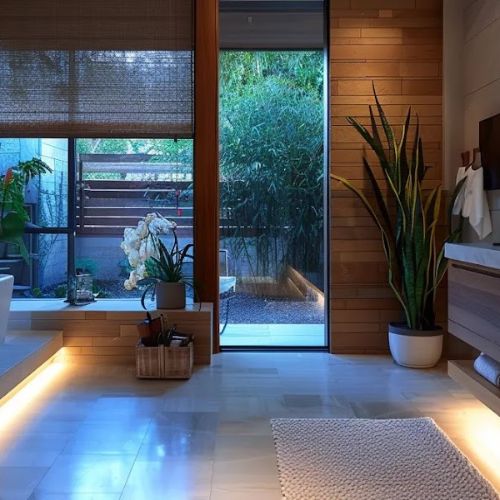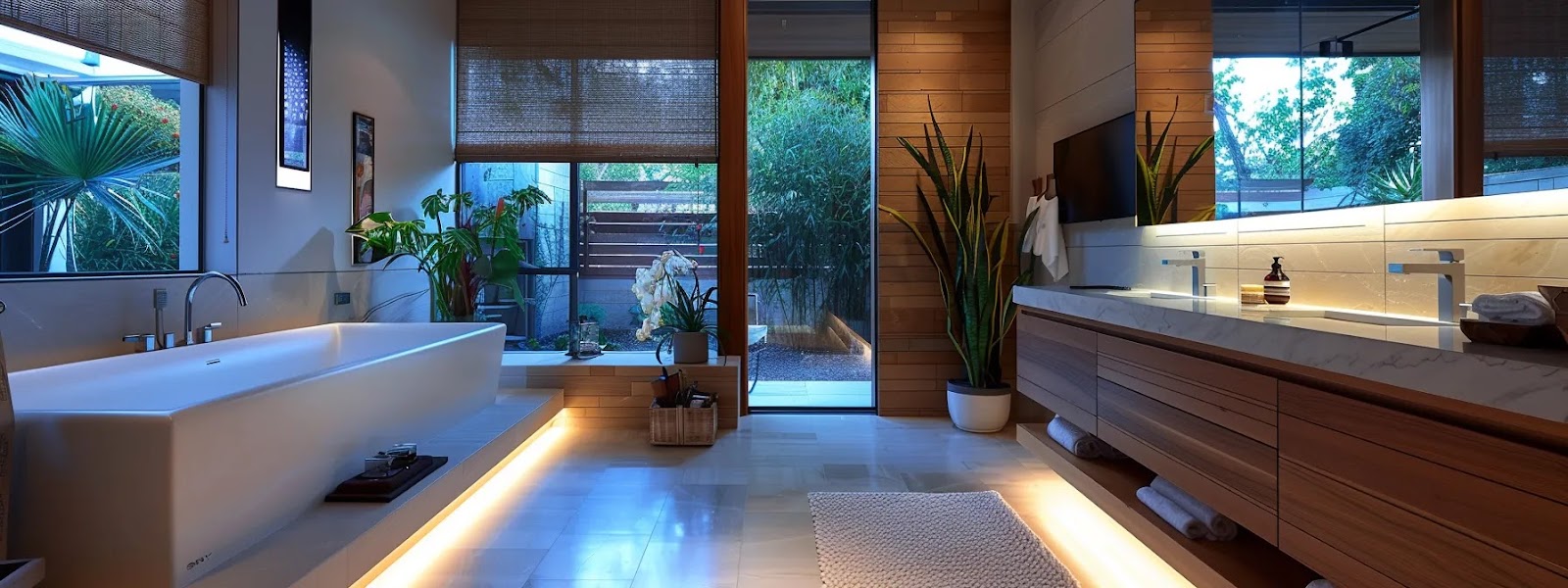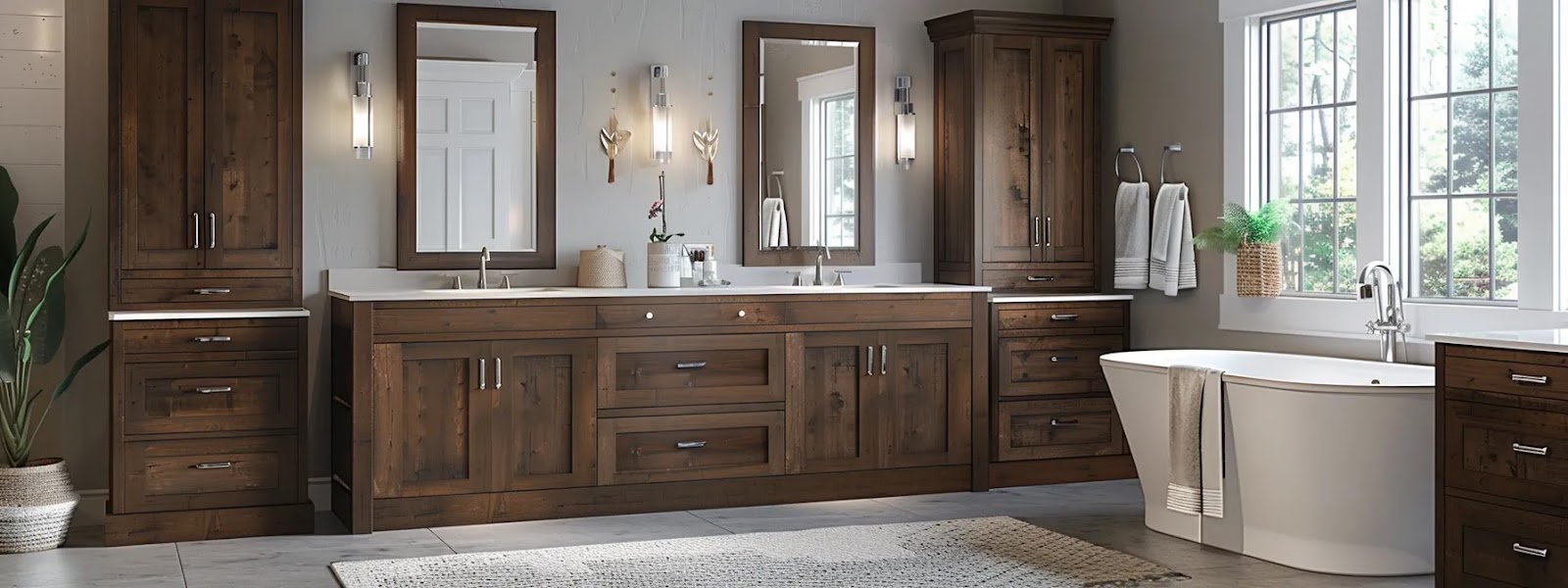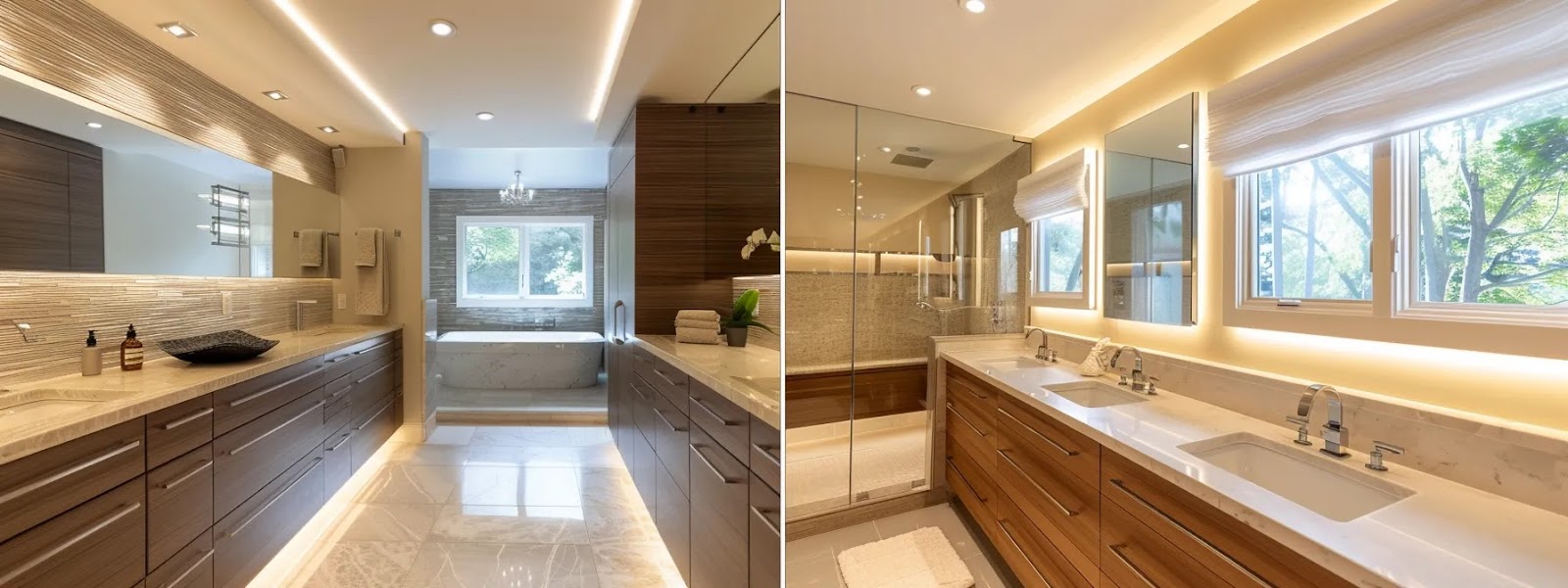Why Are Kitchen Cabinets So Expensive - Pricing Explained
link desc

Plywood is widely considered the best material for bathroom vanity cabinets due to its durability, moisture resistance, and cost-effectiveness. It offers strong structural integrity and a polished wood-grain finish, making it ideal for long-term bathroom use. Solid wood and MDF are also popular choices: solid wood is highly durable and elegant but more expensive, while MDF provides a smooth surface and affordability with decent moisture resistance when properly sealed. Rubberwood is another eco-friendly option with solid durability

This section examines durability for long-lasting use, aesthetic choices for bathroom design, and cost evaluation across various materials for vanity cabinets. It discusses issues like plumbing integration, longevity assurances, wood veneer options for style, and mold resistance to ensure practical insights into the best material for a reliable bathroom vanity.
The evaluation of durability starts with the material's density as a key factor that assures longevity. For example, bathroom vanity cabinets constructed from high-density materials like stainless steel or marble offer exceptional strength, which is essential for withstanding moisture and daily use.
Moreover, designers consider the durability of materials like plastic when integrating accessible bathroom cabinets into modern homes. The combination of resilient materials such as stainless steel and dense marble provides longevity and supports practical needs while addressing common challenges in bathroom installations.
Modern bathroom designs benefit from materials that provide visual appeal and resistance to wear. A combination of engineered wood and granite can bring a sleek look while withstanding daily use and moisture exposure.
Designers consistently recommend ceramic and engineered wood for a bathroom that integrates style with functionality. Practical examples from recent installations suggest that combining these materials can improve the bathroom's overall appearance while reducing long-term wear challenges.
Industry experts from design partners note that composite material options offer a balanced price point, making them preferred choices for both budget and high-end bathroom vanity cabinets. testimonials from customers indicate that these materials can reduce wear and tear, providing long-lasting value and resilient performance even under heavy use.
Research based on particle analysis confirms that composite materials maintain structural integrity and resist daily impacts efficiently. Professionals in the field share testimonials that highlight the practical cost benefits of such cabinetry, reinforcing the notion that investing in quality elements can lower maintenance expenses over time.
This section discusses particle board's advantages and drawbacks, including suitable finishes. Experts note how the material handles heat and compare its look with cherry and plywood finishes. Examples from a cabinetry gallery highlight practical sink setups. The overview leads into detailed reviews of particle board's pros and cons for bathroom vanity cabinets.
Particle board offers a cost-effective option for bathroom vanity cabinets where designers and cabinet makers often consider resin-treated surfaces that resist water damage while maintaining an attractive design. Its lightweight structure makes installation easier and supports versatile finishes such as wax coatings; the material's affordability combined with practical benefits is underscored by its use in areas where concrete elements frequently influence overall layout:
On the other hand, critics note that particle board may lack the long-term durability required in high-moisture environments despite treatments to reduce water absorption. Occasional issues with wax degradation and challenges matching the robust feel of concrete-based designs lead professionals to consider particle board as an interim solution rather than a permanent installation choice.
Particle board upgrades benefit from refined finishes that closely resemble the look of birch and teak, making them suitable for kitchen cabinet environments. Experts note that pairing these finishes with solid wood drawer details produces an attractive yet practical result for vanity cabinetry.
Industry professionals recommend finishes that ensure durability and performance while meeting modern design needs.
Finish
MDF offers practical advantages as a bathroom cabinet material. Experts note its smooth surface benefits from easy soap cleaning and simple maintenance during a bathroom remodel. classic cabinetry shop specialists highlight MDF's durability, making it ideal even when placed near the floor, while practical care tips help ensure lasting performance.
MDF stands out as a reliable option for bathroom vanity cabinets due to its uniform texture and smooth surface, which rivals that of hardwood without the high cost. Its resistance against moisture when paired with suitable finishes creates a balance between beauty and function, making it a smart choice for budget-conscious projects that do not compromise on design.
Industry professionals note MDF's compatibility with engineered stone accents and its ease of maintenance in high-humidity areas, ensuring practical benefits in environments where moisture is a concern: the difference between a closet
This combination of qualities makes MDF a viable option for those seeking durability and beauty in bathroom vanity cabinets.
Experts advise that regular cleaning using a mild soap solution can maintain the pristine appearance of MDF cabinets, especially when compared to other materials like fiberboard and polyvinyl chloride. This practice supports the long-term durability of fabrications that feature a solid surface for interior design applications, ensuring the cabinets preserve their integrity in busy bathroom environments.
Maintenance should include gentle wiping after splashes and periodic checks for surface wear to prevent moisture damage. Specialists recommend following manufacturer guidelines about care procedures, so the MDF cabinets continue to support modern interior design aesthetics and offer a reliable performance similar to other resilient materials like solid surface options.
This section examines plywood's benefits in bathroom vanity cabinets, from its strength and aesthetic appeal to its cost-effectiveness compared to particle board solutions. It also reviews comparing plywood grades for quality, highlighting examples from kitchen remodels and maple accents in commercial services while emphasizing practical insights for optimal wood selection.
Plywood presents a reliable option for bathroom vanity cabinets owing to its solid construction and attractive wood grain, which adds both durability and a refined look to furniture. Experts highlight its ability to resist stain and maintain structural integrity even in demanding environments, making it a dependable choice for lasting cabinetry performance.
Professionals often note that plywood offers a practical balance of strength and aesthetic charm, making it an appealing material for both residential and commercial projects. Its solid contact with design elements and surfaces enhances overall durability while providing a subtle elegance that suits modern cabinetry requirements.
Experts compare plywood grades by examining factors such as overall durability and resistance to moisture, similar to testing quartz under load and steel in extreme conditions; their study notes that high-grade plywood displays enhanced durability that stands up well in settings like a shower, ensuring long-lasting performance.
Industry professionals leverage a table of contents approach when assessing plywood quality, with practical examples showing that higher-grade materials serve well when complemented by other elements, thus mitigating common issues encountered in installations that demand resilience and reliability.

Solid wood offers lasting strength and appealing aesthetics for vanity cabinets. The section covers wood types suitable for cabinet placement, emphasizing environmentally friendly options. It provides care and maintenance tips to manage bacteria buildup and preserve natural beauty, while noting contrasts with porcelain finishes in similar settings.
Expert cabinet makers favor oak for its robust qualities and timeless appeal in woodworking projects, making it an excellent medium for reliable bathroom vanity cabinets during a renovation. Practical applications of solid wood often involve applying a quality sealant to protect surfaces and maintain strength; consider these essential benefits and features:
Industry professionals recommend solid wood types like oak for their proven performance and aesthetic charm in cabinetry. Their expertise in woodworking ensures that these materials provide lasting function and beauty, particularly in renovation projects requiring a sustainable solution.
Regular cleaning with a mild cleaner helps maintain the natural color and finish of solid wood vanity cabinets, while ensuring that any metal accents remain rust-free. To achieve a balanced upkeep that preserves the walnut tones and overall cabinetry appeal, professionals suggest the following routine steps:
Proper care also involves using suitable products that complement the inherent qualities of tree-based materials, ensuring that both the cabinetry and its walnut accents stay vibrant and resilient over time. Practical guidance from experts in solid wood maintenance assists homeowners in managing daily use and long-term wear effectively.
Rubberwood offers eco-friendly features and solid durability, making it a prime candidate for bathroom vanity cabinets. Experts note its balanced weight and smooth finish after a quality paint application. This section explains rubberwood's environmental advantages and its performance durability, providing practical insights for reliable, attractive cabinet solutions.
Rubberwood offers significant environmental benefits for bathroom vanity cabinets, making it an appealing choice among custom cabinetry solutions in Huntsville, Madison, and Ardmore Alabama. Experts note that rubberwood is sourced from sustainably managed plantations, which reduces waste and supports environmentally conscious practices while providing a durable option for bathroom cabinetry.
Industry professionals emphasize that rubberwood's eco-friendly attributes contribute to a reduced carbon footprint during production and installation, aligning with the goals of modern cabinet makers. Its renewable nature and minimal chemical treatments make it a responsible option for homeowners seeking custom cabinets that combine performance with environmental care.
The performance of rubberwood in bathroom vanity cabinets stands out among custom cabinetry options. Industry experts note that its robust nature ensures reliable durability even in moisture-heavy environments, making it an attractive choice for homeowners in Alabama.
Practical evaluations reveal that rubberwood offers consistent stability and lasting strength, which is essential for daily use. Professionals in cabinet making recommend rubberwood for its balanced performance and ease of maintenance, addressing common concerns about longevity and upkeep.
This section explains how to match your bathroom's style and space with the right custom cabinetry. It covers budget limits, lifespan expectations, and useful guidance based on household traffic to help in selecting materials that deliver reliable performance and lasting beauty.
Evaluating the bathroom's style and space is key in selecting the ideal material for custom cabinetry. Experts recommend measuring the area and analyzing design elements to ensure that materials chosen, such as bathroom vanity cabinets crafted from durable MDF or solid wood, complement the overall layout and visual appeal.
Assessing the available space helps cabinet makers determine the best configuration and finish for custom cabinets that meet functional needs and durability standards. Professionals in the field suggest considering both compact designs for minimal bathrooms and expansive forms for larger settings to achieve a balanced, refined result.
Homeowners seeking custom cabinetry for bathroom vanity cabinets must evaluate material costs against long-term value. Experts note that budget-friendly options such as engineered wood or MDF often provide a reliable balance between affordability and durability, ensuring that selections support everyday needs without compromising quality.
Design professionals often advise that cost-effective solutions, when combined with proper finishing techniques, can result in enduring performance for kitchen cabinets designed for bathrooms. This approach allows homeowners to manage expenses effectively while achieving the functionality and style required for a refined bathroom environment.
Industry experts note that lifespan expectations for different materials vary significantly, with options such as MDF and solid wood offering reliable longevity in bathroom vanity cabinets. The choice of material impacts maintenance needs and overall durability, and professional cabinet makers advise weighing upfront costs against long-term performance.
Homeowners can benefit from understanding the realistic durability of each option, whether choosing custom cabinets with engineered wood or a blend of MDF and premium finishes:
The selection of materials for bathroom vanity cabinets should be driven by the expected frequency of use and overall household traffic. Professional cabinet makers emphasize that custom cabinetry made from durable options such as MDF or solid wood can better withstand daily wear in busy settings.
Expert recommendations include considering the specific operational demands of a bathroom when choosing between engineered wood and premium finishes:
These insights help ensure that the chosen custom cabinets maintain their performance and visual appeal over time.

This section offers practical guides for choosing the right materials for custom cabinetry and reviews recent innovations in vanity cabinet design. It also provides expert insights and reviews on vanity options, giving readers practical advice and trusted expertise for selecting high-quality bathroom cabinetry.
Industry experts provide detailed guides for choosing the right materials, highlighting reliable options for custom cabinetry in bathroom vanity cabinets. Their advice combines simple evaluation techniques with practical insights, easing the task of selecting materials that balance durability and design appeal in various bathroom settings.
Specialized resources offer actionable steps and examples for comparing custom cabinet materials, ensuring that homeowners and professionals can identify the best material for bathroom vanity cabinets. These guides focus on real-world performance and finish quality, delivering clear information to help readers improve their renovation projects confidently.
Recent innovations in vanity cabinet design have led to sleek and efficient bathroom vanity cabinets that improve space utilization and durability. Industry experts highlight that customized cabinetry now integrates moisture-resistant finishes and smart storage solutions that benefit homeowners in Alabama and North Alabama.
New designs offer a refreshing approach to custom cabinetry with practical features tailored for modern bathrooms; consider the following improvements:
These elements provide homeowners with a practical way to maintain style without sacrificing functionality.
Industry specialists provide detailed insights on custom cabinetry options, noting how different materials perform in busy bathroom settings. Their reviews on bathroom vanity cabinets highlight the balance of style and durability, guiding homeowners in choosing reliable custom cabinets that meet both aesthetic and functional needs.
Renowned cabinet makers share practical evaluations based on real installations, emphasizing factors such as moisture resistance and finish quality in bathroom vanity cabinets. Their expert insights offer clear guidance for selecting custom cabinetry materials that deliver long-lasting value and stability in daily use.
High-quality plywood offers long-lasting resilience for bathroom vanity cabinets. This material withstands moisture effectively, ensuring stability in bathroom cabinets and making it a prime selection for projects in Huntsville, Alabama and North Alabama areas.
Particle board exhibits lower moisture resistance compared with solid wood alternatives. It requires proper sealing during installation, especially for kitchen cabinets, bathroom cabinets, and commercial cabinets, to minimize damage from damp environments.
MDF in vanity cabinets provides a stable, smooth surface ideal for painting and finishes. Cabinet makers favor it for its affordability and reliability, ensuring custom cabinetry meets high standards in both kitchen cabinets and bathroom cabinets.
Plywood may reduce costs when constructing vanities. Its affordability appeals to homeowners seeking custom cabinet solutions by experienced cabinet makers while keeping durability for installations in kitchens and bathrooms.
Rubberwood shows moderate resistance to moisture if treated correctly with sealants. Classic Cabinetry applies this understanding to ensure that custom kitchen cabinets and other installations retain their strength in wet conditions.
Selecting the right material for a bathroom vanity cabinet shapes both the aesthetic appeal and durability of a space. The guide emphasizes practical evaluations, from moisture resistance and strength to cost efficiency and maintenance needs. Cabinet makers in Alabama utilize these insights to craft custom solutions that meet functional and design requirements. Homeowners gain valuable knowledge to make informed choices that support both daily use and long-term performance.